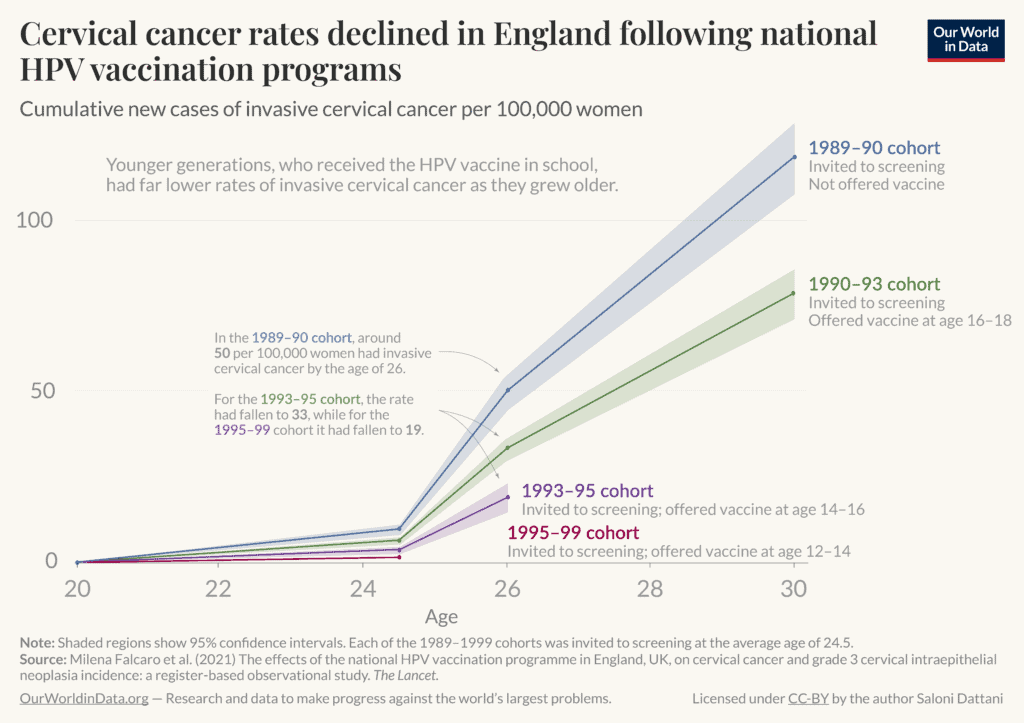Every year, Danish women get their first cervical screening at 23. It’s working wonders: two dangerous viruses are now almost gone.
The improvement happened swiftly. In 2017, Denmark started offering an HPV vaccine covering 4 strains. Before the vaccination, two strains (HPV16 and 18) caused about 70% of cervical cancers. Now, infections with those two HPV types have nearly vanished in the vaccinated group.
A Vaccine that Works Wonders
In Europe, cervical cancer is the second most common cancer in women aged 15–44. It’s almost always caused by the HPV virus. In men, the virus is less prevalent, but it also causes around half of all penis cancers. For over a decade, researchers have proposed that mass vaccination against this virus could drastically reduce the incidence of these cancers. Denmark put it to the test.
These findings come from Trial23, a real-world study embedded in Denmark’s screening program. Researchers analyzed 16,955 cell samples from 8,659 women. Among vaccinated women, HPV16/18 showed up in just 0.4%, 0.3%, and 0.2% of the first, second, and third samples respectively — levels that stayed low over seven years. Even in unvaccinated women, the virus prevalence dropped, which strongly indicates population immunity.
Other, less dangerous types were somewhat less common than before. Researchers say that they could be replacing some of the more dangerous strains. However, the risk is far lower with these strains, and future vaccines could target them as well.
The HPV vaccines have also an excellent safety record and strong effectiveness against precancer. Denmark offers vaccination free to adolescents, now for girls and boys. Even though boys are less vulnerable to HPV, they still benefit from the vaccine and this also stops them from becoming vectors and transmitting the virus.
We Have the Chance to Eliminate a Type of Cancer
It almost sounds like science fiction, but through HPV vaccination, we can essentially eliminate cervical cancer. Denmark shows how big of a difference can emerge in only a few years. But the journey wasn’t smooth.
A media-driven scare in 2015–2016 caused vaccine uptake to crash. The antivaxx crowd lit, despite the overwhelming scientific evidence. Health authorities, clinicians, and the Danish Cancer Society then fought back, launching “Stop HPV — stop cervical cancer,” a direct, evidence-based campaign on social media and beyond. Coverage rebounded, and Denmark later made the program gender-neutral in 2019. Today’s results are the payoff.
Even more encouraging, Denmark isn’t the only place that’s starting to keep cervical cancer under control. The UK has had an even more successful campaign. A landmark study confirmed a dramatic fall in cervical cancer and CIN‑3 lesions among women vaccinated in adolescence. Researchers report that vaccination at ages 12–13 results in an astonishing 87% reduction in cervical cancer incidence, far exceeding earlier expectations.
Furthermore, England’s vaccination programme is having an outsized impact among socially deprived groups — those who historically face higher cancer risks. A study by Cancer Research UK estimates that for every cervical cancer case prevented overall, around three times as many cases were averted in the most deprived groups compared to the least. It turns out the school-based vaccination rollout is helping close long-standing health equity gaps.
Scotland’s results add to the picture: no cervical cancer cases have been detected in fully vaccinated women who received the HPV vaccine at age 12–13 since the programme began in 2008. This finding, drawn from national screening data, underscores how effective early vaccination can be in real‑world conditions.
Real Hope for the Future
Eliminating a type of cancer is no longer just a dream. The HPV story shows it’s possible.
Modern HPV vaccines can block those strains before they ever take hold. When vaccination coverage is high, the virus struggles to spread, infections plummet, and cancer rates follow.
This isn’t theory anymore: countries with strong HPV immunisation programs are already seeing near-elimination of the most dangerous HPV types. With sustained effort, widespread vaccination could make cervical cancer one of the first human cancers we deliberately wipe out.


